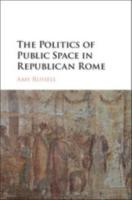
CUP (2016) h/b 226pp £64.99 (ISBN 9781107040496)
Like Roman republican politics, this book is centred metaphorically and physically around the Forum Romanum. Beyond this discussion, however, R. does paint a vivid picture of the use, control and manipulation of space across the city of Rome. The premise of this book is that no space was ever fully or exclusively public, and that this fluid definition came to mean different things in different combinations.
The first quarter of the book addresses the relationship between the words privatus, publicus and politicus, taking us back to basics on the varying meanings of the Latin terms, with particular attention to how they differ from our own understandings of their English equivalents. R.’s main thesis is that the first two of these words are not as much of a dichotomy as we often think them to be. Further, the ownership of public space could sometimes be claimed for political reasons, an action brought out in the example of violence in public spaces in Cicero’s Pro Milone.
This theory underpins the rest of the book. The two following chapters apply it directly to the Forum Romanum, as mentioned, and discuss in detail how the various architectural features of the Forum—and, importantly, the changing buildings that surrounded it in the Republican period—would have influenced the viewers’ understanding of the public and political facets of that space.
In the next two chapters, the discussion turns to the place of sacred space in this construction and to the use of art in public space, respectively. Each shows detailed attention to the topics; however, it only goes as far as considering specific use of these concepts by some individuals for their own (political) benefit. The final chapter brings together all the elements of the book in a case study on the public and private space of Pompey’s complex of temple, theatre and portico, built and dedicated in the 50s BC. Although considerably fewer pages are devoted to this structure than to the Forum, R. still provides a detailed reconstruction of the buildings and their nuances, as well as a brief consideration of the development of its political use after Pompey. For example, Pompey included a public entrance to his adjoined horti; however gated access meant he was still able to control movement within and around it (pp. 166-7).
R.’s main strength in this book is visualising how the space would have looked to Romans of different classes, stations and genders, and how those sights, and viewers, played a role in constructing the space as public and/or private. Although, as R. herself admits, this ‘reconstruction is … inevitably speculative’ (p. 138), she does a very good job of repopulating these ancient public spaces with the people who would have used them.
Chris Mowat
